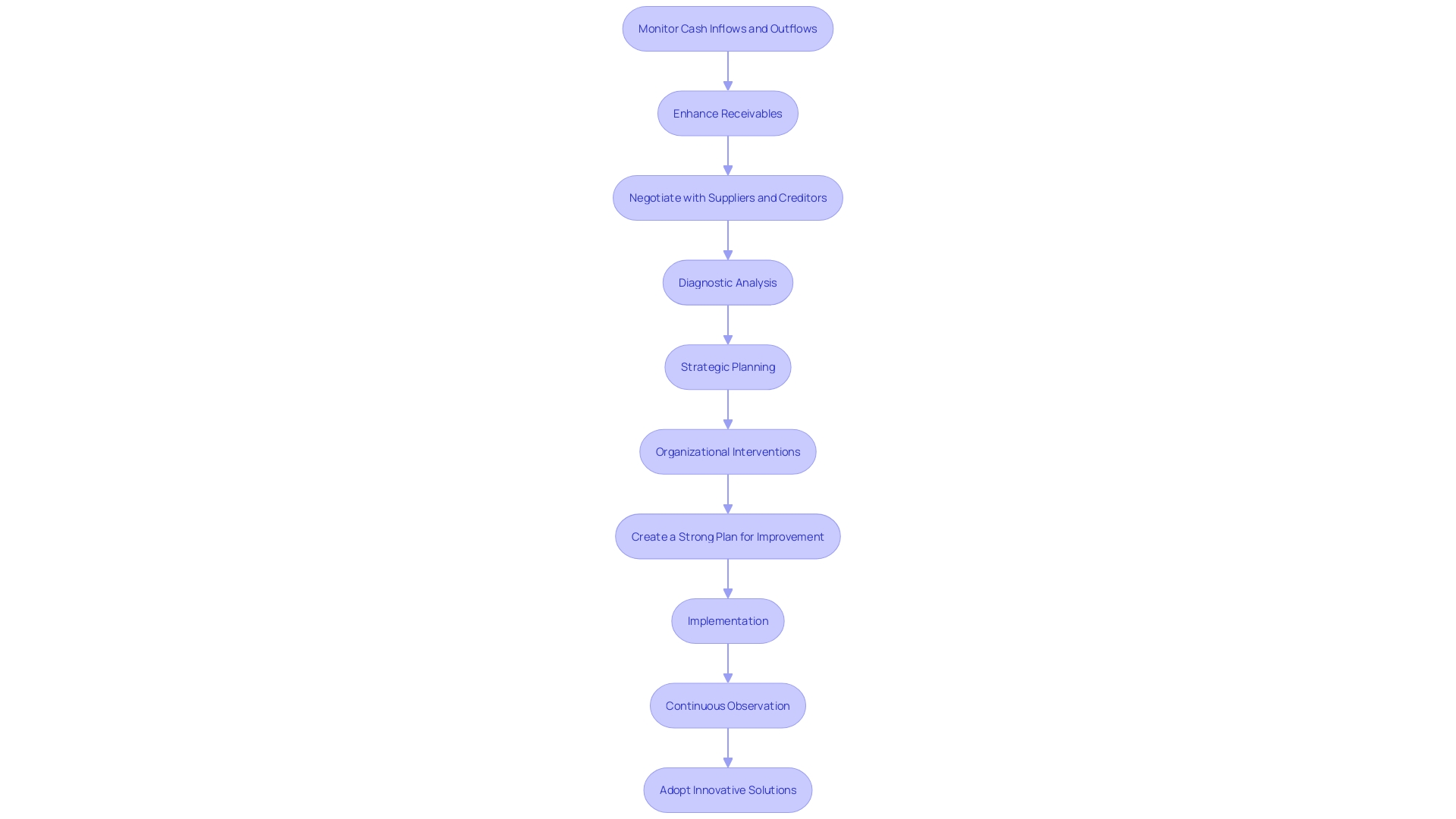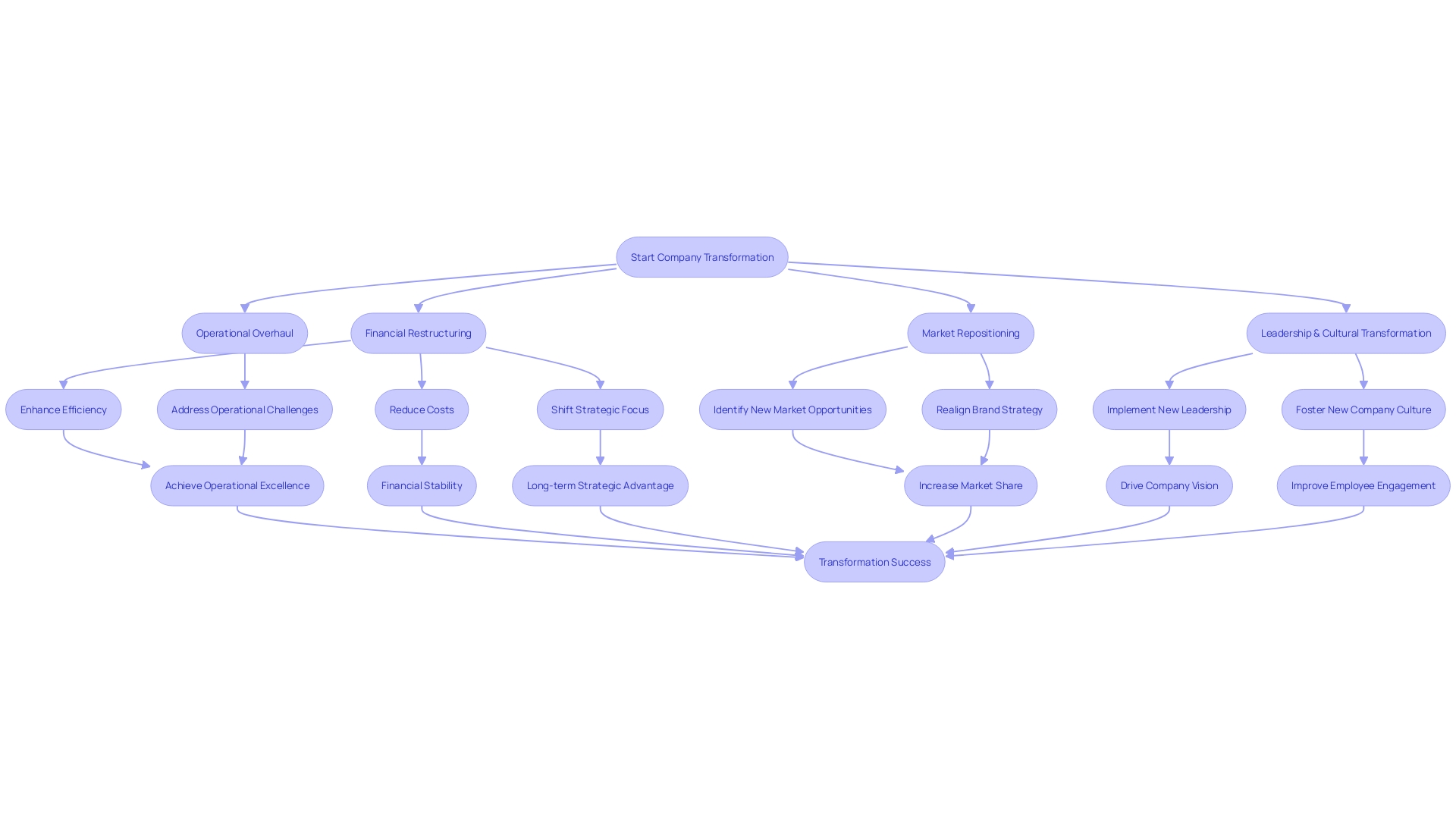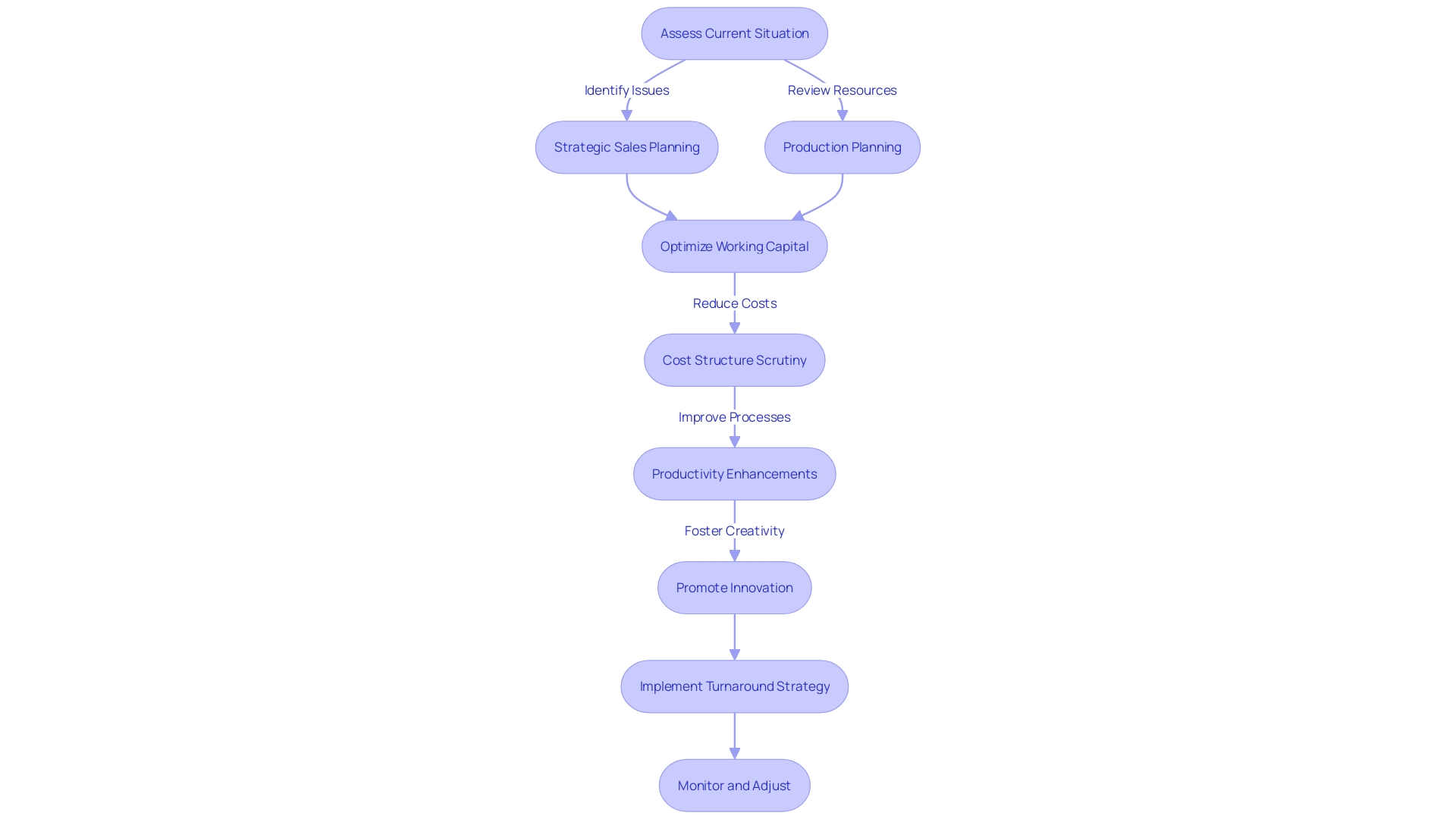Introduction
In today's rapidly changing economic landscape, businesses are often faced with the challenge of a downward spiral. However, with the right approach, companies can execute a successful turnaround strategy to reverse their decline and drive profitability and growth. This article explores the definition and purpose of a turnaround strategy, key steps in the turnaround process, different types of turnaround strategies, and key areas of focus for industrial businesses.
By leveraging real-world examples and strategic analysis, businesses can navigate through tough times and emerge stronger than ever. So, let's dive in and discover the practical advice and solutions that can help businesses thrive in challenging times.
Definition and Purpose of Turnaround Strategy
A turnaround strategy is similar to a rescue mission for organizations experiencing a downward spiral. It's a series of decisive actions aimed at reversing a company's decline and steering it back to profitability and growth. Take, for instance, the case of a prominent hotel that, despite its prime location in the heart of the city, struggled to revitalize its flagging food and beverage sales. The hotel's management knew that to succeed, they needed to deeply understand their market, which is paramount in repositioning any business.
The success of this hotel's story emphasizes the significance of a systematic and data-driven approach. By utilizing its location, the hotel drew in more diners and experienced a remarkable increase in sales and rave reviews in the initial week of implementing their new approach. This story demonstrates the strength of a well-coordinated turnaround plan that extends beyond simple financial modifications and taps into the core of brand positioning and market dynamics.
In crafting such a strategy, an in-depth industry analysis is crucial. It requires understanding the industry's size, trends, and unique challenges. A competitor analysis sheds light on the strengths and weaknesses within the market, while a target market analysis delves into the preferences and behaviors of potential customers. Combined with a comprehensive SWOT analysis to assess internal capabilities and external opportunities, companies can gather and analyze data to guide their strategic decisions.
For enterprises operating in the beauty sector, for instance, possibilities such as grants can spur a transformation. With up to $100,000 in grants available for small business owners, these funds can be instrumental in launching or expanding a business, covering costs from equipment purchases to salon space rentals.
Moreover, a successful turnaround strategy must be anchored by a robust go-to-market (GTM) plan. This comprehensive roadmap outlines how a company will engage its target audience and effectively deliver its products or services. It involves creating customer personas to visualize and cater to the ideal customer profile, thereby maximizing the impact of marketing efforts.
In today's rapidly evolving economic landscape, where technology and competition drive the need for constant adaptation, enterprises must pivot with precision. As Bryan Solis notes, over half of businesses recognize market competition and growth opportunities as catalysts for change. With the U.S. economy at an inflection point, companies must be prepared to act decisively.
In the restaurant industry, where turnover rates are significantly high, comprehending the underlying factors—such as staffing challenges and the demanding nature of the work—can guide a transformation plan that tackles these particular problems. By adopting the appropriate approach, organizations can convert these difficulties into chances for development and adaptability.
In summary, a transformation plan is not a universal answer but a customized set of measures created to tackle the specific difficulties and capitalize on the advantages of an enterprise. By drawing on real-world examples and strategic analysis, companies can navigate through tough times and emerge stronger than before.

Key Steps in a Turnaround Process
Efficient cash flow management is crucial when implementing a company reorganization strategy. This requires vigilant monitoring of cash inflows and outflows, enhancing receivables, and prudent negotiations with suppliers and creditors to improve payment terms or secure new financing avenues. A thorough diagnostic analysis is essential to identify the underlying concerns afflicting the enterprise, which entails a detailed examination of financial statements, operational processes, and market conditions. Using tools such as SWOT analysis can reveal important insights into the internal and external factors impacting the efforts to improve.
Quick wins offer immediate, tangible results that can build momentum and boost morale. They can be achieved through focused strategic planning in areas such as cost reduction, operational efficiency, and revenue enhancement. At the organizational level, interventions may be needed to address systemic issues, which could mean reshuffling the management team, overhauling the organizational structure, or realigning core competencies to meet new objectives.
The creation of a strong plan for improvement involves creating a strategic blueprint that outlines specific goals and practical measures. This plan is supported by a detailed organizational plan aimed at restructuring internal processes and aligning them with the strategic goals, as well as an operational plan that focuses on enhancing efficiency and productivity. The financial plan is a foundation of the business's revival, focusing on cost control, working capital optimization, and securing the required funding.
Implementation and continuous observation are essential for the achievement of a transformation plan. Leadership must show steadfast dedication, efficiently convey the strategy, and involve the entire organization in the process of transformation. Continuous monitoring ensures that the plan adheres to the set benchmarks, allowing for timely adjustments to keep the turnaround on course.
Real-world examples, like Nets' approach to simplifying technical data for clients and eWyse Agency's approach to onboarding new staff, highlight the significance of innovative solutions in overcoming challenges during a company transition. Continuous learning and adaptation to economic trends, as well as leveraging technology for better cash flow management, are essential practices that organizations should adopt to remain competitive and agile.

Types of Turnaround Strategies
Executing a prosperous company transformation plan frequently requires a diverse methodology, customized to the distinct obstacles each enterprise encounters. A comprehensive strategy may include:
-
Financial Restructuring: Essential for businesses looking to enhance their financial health, this approach involves reorganizing debt, renegotiating contracts, and fine-tuning the capital structure for improved fiscal stability.
-
Operational Overhaul: Operational efficiency is key in any turnaround. This can be achieved by streamlining processes, cutting costs, and enhancing overall efficiency to create a leaner operation.
-
Market Repositioning: To stay relevant and competitive, businesses may need to redefine their target market, adjust their offerings, and engage in strategic marketing to attract new customers.
-
Leadership and Cultural Transformation: A shift in leadership style, organizational culture, and values can have a profound impact. This may include management team changes, improved communication, and cultivating an environment that encourages innovation.
Real-life instances, such as Stora Enso's shift from a conventional paper producer to a sustainable materials company, showcase the effectiveness of such approaches. Stora Enso, with a history dating back to 1288, embraced market trends and overhauled its product line to include sustainable alternatives, which resulted in a significant shift in their operations and product offerings.
Moreover, the high rates of employee turnover in the restaurant industry demonstrate the significance of operational efficiency and employee satisfaction in a strategy for improvement. With a 6.1% turnover rate in the industry, compared to 4.9% across all industries, addressing the demands of the work environment and financial stability for employees is crucial.
Current economic conditions also require enterprises to consider long-term goals and make strategic investments and divestments to improve agility. Technology plays a significant role in enhancing efficiency and should be integrated within the forecasting tools to make informed decisions for a successful turnaround.
Data indicates that market rivalry and expansion possibilities prompt 51% of enterprises to adjust their approaches every two to five years. With over 600,000 startups emerging globally, companies must continually evolve to maintain a competitive edge.
When organizing a transformation, establishing an exit plan is just as crucial as the actions and schedules required to achieve the final objective. Whether considering a merger or acquisition or preparing for a public offering, companies must meticulously plan their journey to a successful transformation.

Key Areas to Focus in Industrial Businesses
In the fiercely competitive industrial landscape, organizations must implement strong turnaround strategies to sustain profitability and market presence. Strategic sales and production planning is vital, involving precise demand forecasting and syncing production schedules with customer orders. For instance, the recycled paper industry, a sector with about $90M in annual revenue, has harnessed innovation to remain sustainable and profitable, utilizing fibers up to seven times and underscoring the importance of forward-thinking in production processes.
Optimizing working capital is another cornerstone for success. Through optimizing inventory levels and streamlining accounts receivable and payable cycles, organizations can strengthen their cash flow. Organizations such as Toyota Motor Corporation demonstrate this by their dedication to assisting communities and functioning sustainably, which has been a crucial element in their long existence and evolution into a mobility enterprise.
Cost structure scrutiny is imperative, seeking cost reduction through strategic supplier negotiations, lean manufacturing, and resource optimization. A clear example is Willerby, which has expanded its brand focus and established an owners' club, driving commerce through community engagement and feedback.
Productivity enhancements through technological investments, process automation, and performance metrics are also crucial. With China's industrial sector witnessing a profit rebound due to supportive policies and rising domestic demand, companies are encouraged to adapt to changing economic landscapes for sustained growth.
Lastly, promoting a climate of innovation allows organizations to uncover new markets and gain a competitive edge. The recent unrest in Chinese factories indicates the need for enterprises to also concentrate on employee satisfaction and operational transparency to mitigate risks and ensure stability.
These strategic areas of focus align with the challenges faced by small to mid-sized manufacturing companies, as identified by industry leaders, and are essential for industrial businesses intent on achieving a successful turnaround.

Conclusion
To conclude, a successful turnaround strategy is essential for businesses facing decline. It involves tailored actions, a data-driven approach, and continuous monitoring. Key steps include effective cash flow management, diagnostic analysis, quick wins, and a robust plan.
Different types of strategies, such as financial restructuring and market repositioning, can be implemented. Technology and long-term goals play important roles.
In industrial businesses, focus areas include strategic sales and production planning, optimizing working capital, scrutinizing cost structures, enhancing productivity through technology, and fostering innovation. These align with challenges faced by manufacturing companies.
By following these steps and strategies, businesses can navigate tough times and emerge stronger. It is crucial to act decisively and adapt to changing economic landscapes. With the right approach, businesses can execute a successful turnaround strategy and drive profitability and growth.




